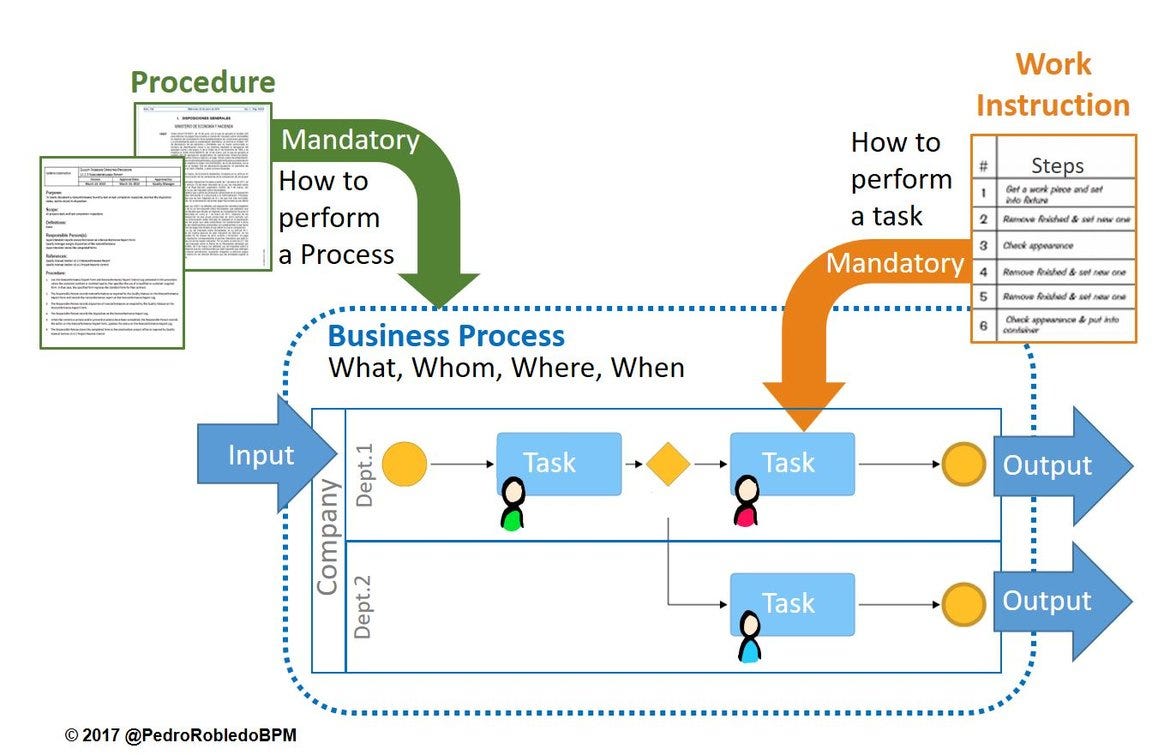A Comprehensive Guide for Quality Management and UX Excellence
The Importance of Clarity in Business Operations
In today’s fast-paced business environment, clarity in operational documentation isn’t just a compliance requirement—it’s a cornerstone of efficiency, user satisfaction, and scalability. Yet, terms like processes, procedures, and work instructions are often used interchangeably, leading to confusion, inefficiencies, and even compliance risks.
Drawing from ISO standards, Business Process Model and Notation (BPMN), and UX design principles, this guide will dissect these concepts, highlight their differences, and demonstrate how they interconnect to create seamless workflows.
1. What is a Business Process?
Definition (ISO 9001:2015):
A business process is a “set of related or interacting activities that transform inputs into outputs” (ISO 9001:2015). Processes answer the what, whom, where, and when of operations.
Key Characteristics:
- High-level orchestration: Processes map the flow of activities across departments (e.g., “Order Fulfillment”).
- Cross-functional: Involve multiple roles (e.g., sales, logistics, finance).
- Modeled in BPMN: Visualized using standards like BPMN 2.0 to show start/end points, decision gates, and roles (BPMN Specification).
Example:
A Customer Onboarding Process might include steps like account creation, verification, and welcome communication. Each step involves different teams but follows a unified workflow.
2. Understanding Procedures: The “How” of Processes
Definition (ISO 9001:2015):
A procedure is a “specified way to carry out an activity or a process” (ISO 9001:2015). Procedures are mandatory and answer the how and why.
Key Characteristics:
- Detailed guidance: Explains methods without diving into granular steps (e.g., “Purchasing Procedure”).
- Compliance-driven: Often tied to legal or regulatory requirements (e.g., FDA compliance in healthcare).
- Cross-departmental: May involve multiple teams (e.g., procurement, legal, finance).
Example:
A Supplier Evaluation Procedure outlines criteria for selecting vendors, roles responsible for approvals, and compliance checks.
3. Work Instructions: The Step-by-Step Guides
Definition:
Work instructions are task-specific documents that detail exact steps to perform an activity. They are mandatory and focus on one role performing one task.
Key Characteristics:
- Granular detail: Leave no ambiguity (e.g., “How to Submit an Expense Report in SAP”).
- Single-role focus: Used by frontline employees (e.g., machine operators, data entry clerks).
- Visual aids: Often include screenshots, flowcharts, or videos for clarity.
Example:
A Work Instruction for Invoice Automation might list steps like:
- Log into the ERP system.
- Navigate to the “Vendor Invoices” tab.
- Upload scanned invoices using the drag-and-drop feature.
4. Key Differences Summarized
| Aspect | Process | Procedure | Work Instruction |
|---|---|---|---|
| Scope | Cross-departmental | Cross-functional or single BU | Single department/role |
| Detail Level | High-level workflow | Method without full specifics | Step-by-step directions |
| Mandatory? | No (may have optional paths) | Yes | Yes |
| ISO 9001 Role | Defines system interactions | Specifies compliance methods | Ensures task consistency |
5. How These Elements Interconnect in Quality Management
A well-structured Quality Management System (QMS) relies on all three:
- Processes define the big picture.
- Procedures ensure compliance within those processes.
- Work instructions guarantee task-level consistency.
For example, in a pharmaceutical company:
- Process: Drug Manufacturing (inputs → outputs).
- Procedure: Sterilization Protocol (meets FDA standards).
- Work Instruction: Operating Autoclave Machine (exact temperature settings, timings).
6. The Role of UX Design in Streamlining Documentation
As UX designers, our goal is to make documentation user-centric. Poorly designed processes confuse employees, leading to errors and frustration. Here’s how UX principles apply:
- Information Architecture: Structure documents hierarchically (process → procedure → work instruction).
- Visual Clarity: Use BPMN diagrams for processes and flowcharts for procedures (Figma BPMN Templates).
- Usability Testing: Validate instructions with end-users to identify ambiguities.
Case Study:
A retail client reduced onboarding errors by 40% after redesigning work instructions with annotated screenshots and interactive checklists (NNGroup Case Study).
7. Best Practices for Documenting Processes, Procedures, and Work Instructions
- Processes:
- Use BPMN for visual standardization.
- Identify decision points and exceptions (e.g., “Handle Customer Complaint”).
- Procedures:
- Go to relevant ISO clauses (e.g., ISO 9001:2015 Clause 8.5).
- Include risk assessments (e.g., “Mitigating Supplier Delays”).
- Work Instructions:
- Use numbered lists and visuals.
- Update regularly with user feedback.
Tool Recommendations:
- Lucidchart for BPMN (Lucidchart).
- Scribe for automated work instructions (Scribe).
8. Common Pitfalls to Avoid
- Mixing Terms: Calling a work instruction a “procedure” confuses accountability.
- Overcomplicating: Avoid redundant steps; simplify using the 80/20 rule.
- Ignoring Updates: Outdated instructions lead to non-compliance (e.g., GDPR changes).
Conclusion: Enhancing Efficiency Through Clear Documentation
Processes, procedures, and work instructions are not mere paperwork—they’re the backbone of operational excellence.
By aligning them with ISO standards, leveraging BPMN, and applying UX principles, organizations can reduce errors, improve compliance, and empower employees.
Remember: A well-documented process isn’t just about what you do—it’s about making every step intuitive for the people who execute it.
Further Reading:


